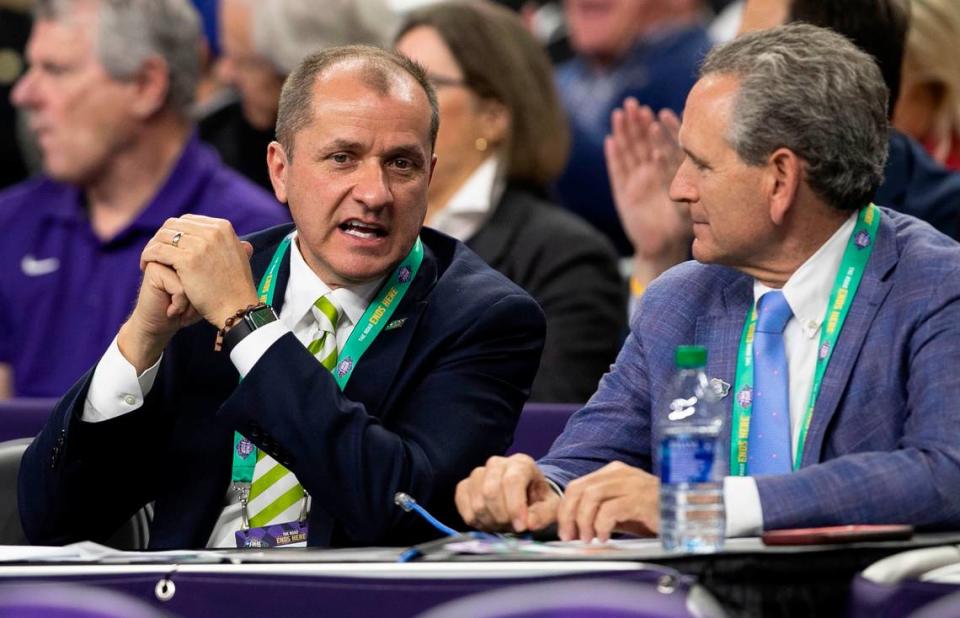UNC’s Bubba Cunningham ready for his turn in March Madness’ hottest seat

A few years ago, when Bubba Cunningham joined the NCAA men’s basketball committee and found himself on the path toward becoming chairman, he couldn’t ever have envisioned some of the challenges the selection committee will face this year.
There’s already the new conundrum presented by transfer-portal turnover, where some rosters take months to coalesce, making it difficult to assess who’s actually playing well as February turns to March. That’s one reason for the ACC’s annual postseason redemption, with Miami in the Final Four as a No. 5 seed in 2023 and N.C. State this spring as an 11. (Connecticut, on the other hand, has presented few such complications.)
And now, this is the first year post-Pac-12, with the Big Ten, Big 12, SEC and ACC all swollen to new memberships, which not only means reassessing long-held assumptions about what it means to be a .500 team in conference play in a 16-, 17- or 18-team league but complicates keeping conference opponents apart in the bracketing as long as possible, a standard which was already relaxed a few years back.
But even if this isn’t exactly what the North Carolina athletic director expected when he signed up for the job — pick a few Final Four and tournament sites, herd cats for a week in Indianapolis to come up with a bracket and then go on CBS after the selection show and try not to sound stupid — it is still one of the most visible and important one-year jobs in college athletics. That hasn’t changed, nor the honor that attaches to it over the next eight months and change before his reign ends in San Antonio in April.
“I’m excited about it,” Cunningham said. “The basketball tournament is such a huge event for the NCAA and, quite frankly, for the country. Everyone dials into college basketball, and right after college basketball we go right into the Masters. It’s just part of the sports cycle in the U.S.
“I think it’s really cool, having been in college athletics at schools that didn’t get in the tournament very often, and now at a school that gets in on a pretty regular basis. To be in the middle of that discussion and debate about what’s good about the tournament and what can be tweaked made better, professionally it’s a great learning experience.”
ACC getting five teams into tournament should be motivation, not relief
Cunningham has spent the past four tournaments overseeing sites as a member of the committee, and not always where UNC is, but being chairman comes with a whole different set of responsibilities, starting with expansion, which has been discussed at some length but remains tabled for the moment. His committee will also pick a site for the 2031 Final Four and sites for the rest of the tournament in 2027 and 2028 this fall.
But he’s already shepherded through one welcome and needed change to the selection process, adding Wins Above Bubble to the team sheets, generally considered by basketball analytics gurus to be the best of the resume metrics. It’s complicated under the hood, but essentially, WAB assigns a value to every win or loss and ends up with a measure of how many wins better (or worse) you did against your schedule than a theoretical 68th and final team into the NCAA tournament would have done.
The committee could pick the whole field that way if it so desired — and ditch the antiquated, arbitrary “quadrants” in the process — but at the least it’s an additional tool that should lead to a better selection process. The version the NCAA will use will be based on the NCAA’s own (and occasionally derided) NET metric, and Cunningham wants to take a step back and examine that to see if it’s doing what it’s supposed to be doing.
“We’re going to have some ongoing conversations with the analytics group about the NET to ensure that it’s really reflective of what we want it to do,” Cunningham said. “As we’ve said, it’s a sorting tool, but anytime you have a data set you’ve used for five or six years, you have four or five years of data to support that and we want to take a look and see if it’s still appropriate.”
Every committee uses the NET and all the other numbers on the team sheets differently — the committee also added Bart Torvik’s power ratings this year — but this group will be especially interesting to observe because as the committee has expanded from 10 members to 12, the number of power conferences in basketball has contracted from six to five. So if the old 10-member committee was made up of 60 percent power-conference representatives, this one will only have 42 percent.
So for assessing a team that’s, say, 8-9 in Quadrant 1 games against a team that’s 3-1, if members from power conferences were focused on raw Q1 wins, would a committee that leans away from the Power 5 be more interested in Q1 winning percentage?
“Everyone would like one answer, the magic bullet,” Cunningham said. “But there’s not one, and so it always comes down to what everyone says: These things are all cliche, I know, but who’d you play? Where’d you play? How’d you do?”
Whatever the answers, it’ll be Cunningham who has to explain them on national TV when the 68 teams are finalized. After that, he’ll be along for the three-week ride like everyone else.
Never miss a Luke DeCock column. Sign up at tinyurl.com/lukeslatest to have them delivered directly to your email inbox as soon as they post.
Luke DeCock’s Latest: Never miss a column on the Canes, ACC or other Triangle sports

 Yahoo Sports
Yahoo Sports 
